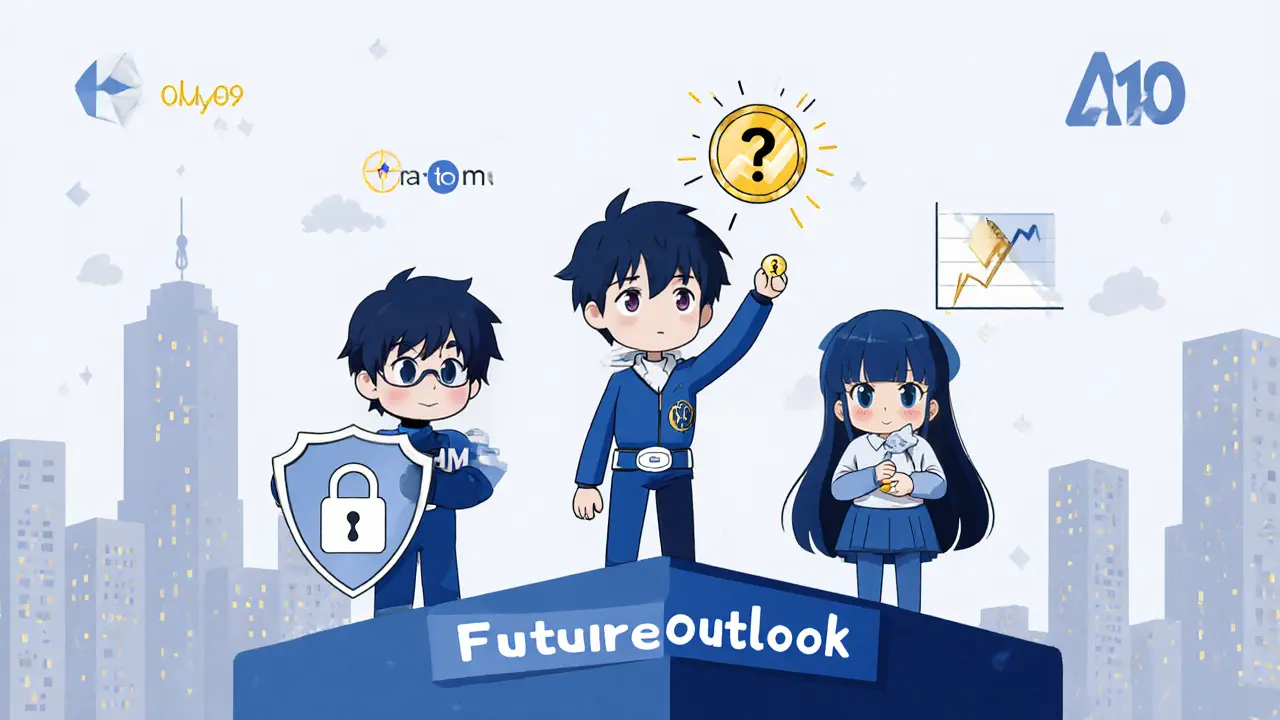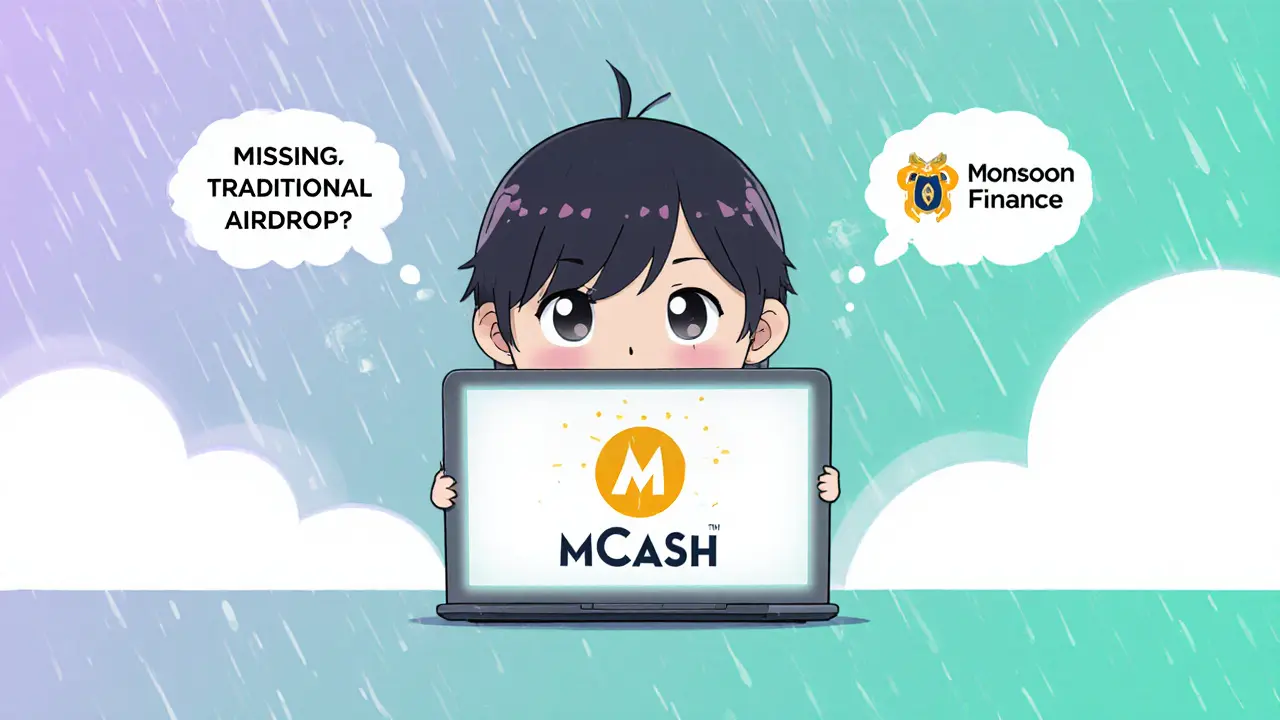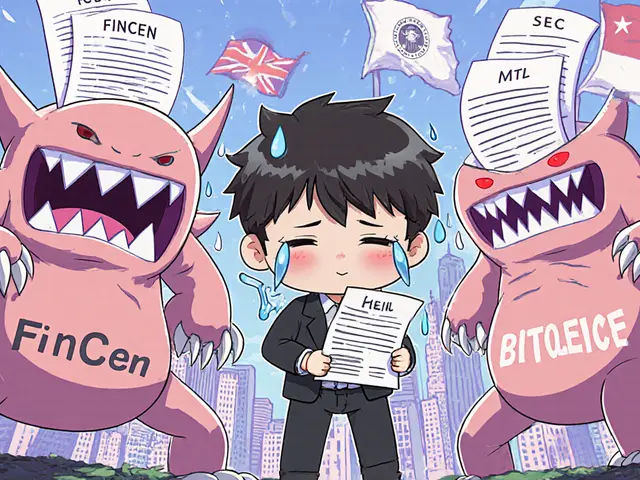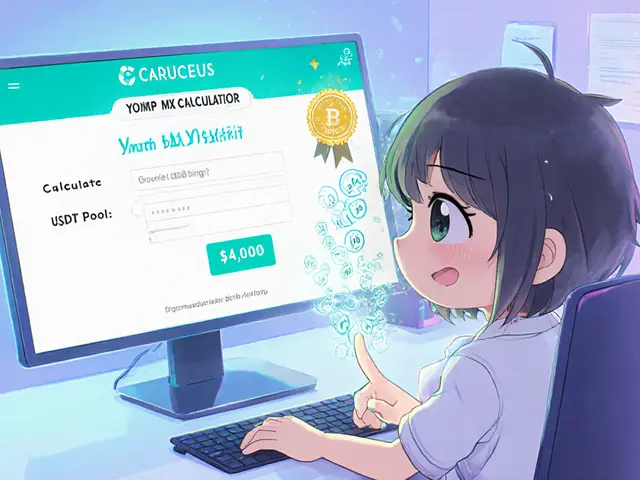MCASH Earnings Calculator
Your Estimated MCASH Earnings
Based on a $0 transaction at 0.5% emission rate.
Ever wondered why you haven’t seen a classic free‑token drop for Monsoon Finance? The project swapped the usual giveaway for something they call anonymity mining - a usage‑based reward system that hands out MCASH only to people who actually use the privacy bridge. If you’re trying to figure out whether it’s worth your time, how the tokens are released, and what pitfalls to avoid, you’ve landed in the right spot.
TL;DR - Quick Takeaways
- Monsoon Finance does not run a traditional airdrop; rewards come from anonymity mining when you use its privacy services.
- Token supply: 100million MCASH; circulating supply just over 2million.
- Initial distribution: 50% released at the Token Generation Event (TGE), then monthly 25% cliffs.
- Earn MCASH by depositing assets on one chain and withdrawing privately on another - the more volume you move, the more you earn.
- Liquidity is thin, price volatile, and ROI from early rounds is now negative - treat MCASH as a high‑risk, experimental asset.
Let’s break down everything you need to know, from the tech that powers MCASH to the step‑by‑step guide for earning tokens, and finally, the red flags you should keep an eye on.
What Is MCASH and Why Does It Matter?
When you first see MCASH a governance token for Monsoon Finance’s cross‑chain privacy protocol, the name alone doesn’t reveal its purpose. MCASH sits at the heart of a platform built to hide transaction details across multiple blockchains - Solana, Moonbeam, BSC, Polygon, and Fantom. The protocol uses zkSNARKs zero‑knowledge proofs that verify a transaction without exposing its data, a tech stack usually reserved for privacy coins like Zcash.
The big promise is simple: you can move funds on one chain, let Monsoon’s bridge encrypt the route, and withdraw the same amount on any other supported chain without anyone seeing the path. For DeFi traders who hop between ecosystems, that privacy layer can be a game‑changer, especially as regulators tighten the net around on‑chain transparency.
How Was MCASH Distributed?
Monsoon Finance launched its Token Generation Event (TGE) on 30September2021 at 02:05UTC+3. Instead of dumping the whole 100million supply at once, the team used a tiered release schedule:
- 50% - Immediate release at the TGE.
- 25% - Monthly cliff for the next two months.
- Additional platform‑specific releases, e.g., BullPerks gave 8% at TGE then 10% every 30days for 270days.
Out of the total supply, only about 6.97% went to private/pre‑sale investors and less than 1% to public sales. The remaining tokens fund development, community incentives, and the anonymity‑mining pool.
What Is Anonymity Mining and How Does It Replace an Airdrop?
Unlike a classic airdrop where you get a free allocation just for holding an address, Monsoon Finance rewards users who actually use the privacy bridge. The process works like this:
- Connect a supported wallet (Metamask, Phantom, etc.) to the Monsoon interface.
- Deposit a supported asset (e.g., USDC on Solana) into the privacy pool.
- Choose a target chain and request a private withdrawal.
- The protocol records the transaction volume and, according to a pre‑defined emission curve, mints MCASH to your address.
The more value you move, the larger the share of newly minted MCASH you receive. This “pay‑for‑privacy” model aligns incentives: the network grows only when users actually need privacy, and token holders also become voters in the protocol’s governance.

Step‑by‑Step Guide to Earn MCASH via Anonymity Mining
Ready to try it out? Follow these steps, and you’ll be on your way to earning MCASH without a traditional airdrop.
- Set up a multi‑chain wallet. Install Metamask (for BSC, Polygon, Fantom) and Phantom (for Solana). Keep a backup of your seed phrase.
- Buy a supported asset. Most users start with USDC or USDT because they’re stable and accepted across all supported chains.
- Visit the Monsoon Finance dashboard. Monsoon Finance the cross‑chain privacy platform where anonymity mining occurs - you’ll see a “Deposit” button.
- Select the source chain and amount.
- Initiate a private withdrawal. Choose a destination chain, confirm the transaction, and pay the small bridge fee (usually a fraction of 1%).
- Claim your MCASH reward. After the withdrawal finalizes (usually within a few minutes), the dashboard shows an “Earned MCASH” badge. Click “Claim” and the tokens appear in your wallet.
- Stake or vote. You can lock MCASH in the governance contract to earn a share of protocol fees, or vote on proposals that shape future development.
Tip: Early‑adopter rewards are higher because the emission curve is front‑loaded. If you’re comfortable with a bit of technical setup, moving $1,000‑$5,000 worth of assets in the first month can net you a few hundred MCASH, which at today’s price (~$0.0003) is still modest but can increase as the ecosystem grows.
Token Economics - Numbers You Can’t Ignore
Here’s a quick snapshot of the hard data you’ll need to assess risk:
| Category | Amount (tokens) | Percentage of Total Supply | Current Market Price (USD) |
|---|---|---|---|
| Total Supply | 100,000,000 | 100% | - |
| Circulating Supply (as of Oct2025) | 2,100,000 | 2.1% | - |
| Private/Pre‑sale Allocation | 6,970,000 | 6.97% | $0.08 (seed round price) |
| Public Sale | 875,000 | 0.88% | $0.20 (IDO price) |
| Anonymity Mining Pool | ~70,000,000 | ~70% | Dynamic (minted per usage) |
The market cap sits around $445K with a fully‑diluted valuation of $20M. That gap shows how much of the supply is still locked or unminted, meaning future inflation could be significant if usage spikes.
Pros and Cons - Should You Jump In?
Pros
- Privacy‑first architecture: Uses zkSNARKs, which are considered cryptographically strong.
- Earn‑while‑you‑use model: Rewards are tied to actual activity, not just speculation.
- Cross‑chain flexibility: Works across five major networks, opening arbitrage opportunities.
Cons
- Liquidity crunch: Trading volume often drops to near‑zero on major DEXes, making it hard to sell.
- Negative ROI for early investors: Most funding rounds are now down 99% from entry price.
- Technical barrier: You need to understand zero‑knowledge proofs and manage multiple wallets.
If you love privacy tech and don’t mind holding a thinly‑traded token, MCASH can be a fun experiment. If you need liquid assets for short‑term trading, look elsewhere.
Common Pitfalls and How to Avoid Them
- Skipping the wallet backup. Losing the seed phrase means losing any MCASH you earn. Store it offline.
- Sending unsupported assets. The bridge only accepts certain tokens. Sending a random ERC‑20 will be rejected and you could lose gas fees.
- Expecting instant profits. Because emission rates decay over time, early heavy usage yields more tokens than later, but the market price may not keep up.
- Ignoring gas costs. Moving assets across chains can be pricey on congested networks; factor that into your ROI calculation.
Future Outlook - Where Is MCASH Headed?
Monsoon Finance continues to upgrade its zkSNARK ceremony and add new chains (Arbitrum is rumored for Q12026). The team’s roadmap mentions a land‑grab strategy: integrate with popular DeFi aggregators so users can hide swaps in a single click. If that happens, anonymity mining could see a surge in volume, potentially boosting token price.
However, the lack of a traditional airdrop limits viral growth. Many projects use big‑ticket giveaways to attract a wave of retail users; Monsoon relies on organic adoption through privacy demand. Until regulations force broader privacy adoption, MCASH will likely stay a niche asset.

Frequently Asked Questions
Is there any free MCASH airdrop I can claim?
Monsoon Finance does not run a classic free‑token airdrop. The only way to receive MCASH is by using the privacy bridge and earning rewards through anonymity mining.
How many MCASH can I earn per transaction?
Rewards follow a tiered emission curve: the first 10% of total bridge volume each month yields the highest MCASH per dollar moved. Exact figures are published on the dashboard and adjust based on total network usage.
What wallets are compatible with Monsoon Finance?
Metamask works for BSC, Polygon, and Fantom; Phantom is used for Solana. Both need to be connected to the Monsoon web interface.
Can I stake MCASH for passive income?
Yes. The protocol offers a governance‑staking module that distributes a portion of bridge fees to stakers. Returns are variable and depend on overall network activity.
Is MCASH listed on major exchanges?
MCASH trades on a few DEXes (e.g., PancakeSwap, QuickSwap) but has negligible volume. No listings on centralized exchanges as of Oct2025.
Bottom line: Monsoon Finance’s “airdrop” is really an incentive to use its privacy bridge. If you’re comfortable navigating multiple wallets, understand that the token is still very illiquid, and you’re okay with a high‑risk speculative play, the anonymity‑mining route can be rewarding. Otherwise, treat MCASH as an experimental token you keep for curiosity rather than a portfolio cornerstone.




Anne Zaya
September 12, 2025 AT 18:09The MCASH airdrop looks like another crypto hype wave, but remember to do your own research.
Emma Szabo
September 16, 2025 AT 13:21Delving into the MCASH airdrop feels like opening a treasure chest of possibilities, each gleaming with potential profit and learning. The platform’s interface is surprisingly user‑friendly, letting newcomers navigate without a steep learning curve. By staking modest transaction volumes, participants can steadily accumulate tokens, turning small daily trades into a meaningful bounty. Remember, the emission rate tapers, so the early birds truly get the worm, but it’s never too late to start building a habit. Keep an eye on community updates, as they often sprinkle hidden bonuses and tips that amplify earnings.
Fiona Lam
September 20, 2025 AT 08:33Yo, this MCASH airdrop is pure hype garbage unless you actually move your money fast. The system rewards the heavy hitters, so if you’re not throwing big trades, you’re basically invisible. Stop whining and either jump in or stop complaining.
OLAOLUWAPO SANDA
September 24, 2025 AT 03:45I’m skeptical that the MCASH airdrop will deliver any real value; it’s just a ploy to inflate user numbers.
Alex Yepes
September 27, 2025 AT 22:57The Monsoon Finance MCASH airdrop presents a multifaceted proposition that warrants careful scrutiny. First, the distribution mechanism is predicated on transaction volume, aligning rewards with network activity. Such a model can incentivize legitimate usage, yet it simultaneously creates a vector for wash‑trading. Potential participants should therefore quantify their exposure not only in nominal MCASH but also in the underlying volatility of the token. Moreover, the emission rate, advertised as diminishing over time, introduces a temporal decay factor that favors early adopters. Early participants may reap disproportionately higher yields, a characteristic reminiscent of many initial‑coin‑offerings. Conversely, latecomers might find the marginal benefit negligible, especially if the token’s market cap inflates. From a regulatory perspective, airdrops can be interpreted as securities distributions, depending on jurisdiction. Consequently, users in certain regions should verify compliance with local financial laws before engaging. Technical risk is also non‑trivial; smart‑contract vulnerabilities could expose funds to exploitation. Historical precedents, such as the XYZ incident, illustrate how insufficient audits can lead to substantial losses. In addition, the platform’s liquidity pools require sufficient depth to avoid slippage during conversion. Participants should assess whether the platform’s tokenomics support sustainable liquidity provision. Strategically, diversifying across multiple airdrops can mitigate the concentration risk associated with MCASH. Finally, maintaining a thorough record of transactions will facilitate tax reporting and future audits.
Sumedha Nag
October 1, 2025 AT 18:09Honestly, I think the whole airdrop hype is just a marketing stunt to get people to pump the token.
Holly Harrar
October 5, 2025 AT 13:21Here's a quick tip: double‑check the contract address before you claim, 'cause scammers love to spoof these airdrops.
Vijay Kumar
October 9, 2025 AT 08:33While the MCASH airdrop can be a fun way to dip your toes into DeFi, make sure you set a strict budget and treat any earnings as a bonus rather than guaranteed income. Track your transaction volumes, and compare the marginal MCASH you earn against gas fees to ensure you’re not losing money on the side.
Edgardo Rodriguez
October 13, 2025 AT 03:45It is worth noting, however, that the airdrop’s success, while promising, depends heavily on user adoption, network stability, and the continued development of the Monsoon Finance ecosystem; consequently, participants should monitor platform announcements, assess token liquidity, and remain vigilant for any policy changes that could affect distribution.
mudassir khan
October 16, 2025 AT 22:57The MCASH airdrop, in my professional opinion, appears to be nothing more than a superficial promotional campaign, replete with inflated promises, lackluster utility, and a potential for regulatory scrutiny; therefore, investors would be well advised to approach this offering with considerable skepticism, and perhaps allocate resources elsewhere.
Bianca Giagante
October 20, 2025 AT 18:09Indeed, the points raised about user adoption and platform stability are essential; maintaining a proactive stance, staying informed, and diversifying exposure can mitigate many of the risks associated with such airdrops.
Andrew Else
October 24, 2025 AT 13:21Oh sure, because reading the fine print is everyone's favorite pastime.
Susan Brindle Kerr
October 28, 2025 AT 08:33It’s utterly tragic how many people dive headfirst without a single clue.
Jared Carline
November 1, 2025 AT 03:45From a strategic standpoint, the purported benefits of the MCASH airdrop appear overstated; a rigorous cost‑benefit analysis suggests that the incremental gains are marginal when juxtaposed with transaction overheads, and thus participants may be better served directing capital toward more substantiated ventures.
raghavan veera
November 4, 2025 AT 22:57Yet one could argue that the value of an airdrop lies not merely in its immediate monetary payoff but in the community cohesion it fosters, prompting users to engage, discuss, and collectively shape the ecosystem's future.
Danielle Thompson
November 8, 2025 AT 18:09Stay steady, keep learning, and you’ll navigate this safely! 😊
Eric Levesque
November 12, 2025 AT 13:21Only the strong survive in crypto, so push forward and claim what’s yours.
alex demaisip
November 16, 2025 AT 08:33In the context of decentralized finance, the MCASH airdrop functions as a liquidity incentive mechanism, calibrated via a volumetric emission coefficient, which ostensibly aligns token distribution with on‑chain activity metrics, thereby fostering a symbiotic equilibrium between user engagement and tokenomic sustainability.
Elmer Detres
November 20, 2025 AT 03:45That’s a solid breakdown! 🌟 While the math looks sound, remember that network externalities and user sentiment ultimately dictate long‑term viability-so keep an eye on community health.